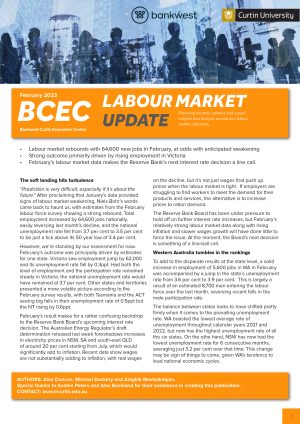BCEC Monthly Labour Market Update – February 2023
- Labour market rebounds with 64,600 new jobs in February, at odds with anticipated weakening.
- Strong outcome primarily driven by rising employment in Victoria.
- February’s labour market data makes the Reserve Bank’s next interest rate decision a line call.
The soft landing hits turbulence
“Prediction is very difficult, especially if it’s about the future.”
After proclaiming that January’s data provided signs of labour market weakening, Niels Bohr’s words came back to haunt us, with estimates from the February labour force survey showing a strong rebound.
Total employment increased by 64,600 jobs nationally, easily reversing last month’s decline, and the national unemployment rate fell from 3.7 per cent to 3.5 per cent to be just a tick above its 50 year low of 3.4 per cent.
However, we’re standing by our assessment for now. February’s outcome was principally driven by estimates for one state.
Victoria saw employment jump by 62,000 and its unemployment rate fall by 0.3ppt.
Had both the level of employment and the participation rate remained steady in Victoria, the national unemployment rate would have remained at 3.7 per cent.
Other states and territories presented a more volatile picture according to the February survey results, with both Tasmania and the ACT seeing big falls in their unemployment rate of 0.5ppt but the NT rising by 0.6ppt.
February’s result makes for a rather confusing backdrop to the Reserve Bank Board’s upcoming interest rate decision.
The Australian Energy Regulator’s draft determination released last week foreshadows increases in electricity prices in NSW, SA and south-east QLD of around 20 per cent starting from July, which would significantly add to inflation.
Recent data show wages are not substantially adding to inflation, with real wages on the decline, but it’s not just wages that push up prices when the labour market is tight.
If employers are struggling to find workers to meet the demand for their products and services, the alternative is to increase prices to ration demand.
The Reserve Bank Board has been under pressure to hold off on further interest rate increases, but February’s relatively strong labour market data along with rising inflation and slower wages growth will have done little to force the issue.
At the moment, the Board’s next decision is something of a line-ball call.
Western Australia tumbles in the rankings
To add to the disparate results at the state level, a solid increase in employment of 5,600 jobs in WA in February was accompanied by a jump in the state’s unemployment rate from 3.6 per cent to 3.9 per cent.
This is largely a result of an estimated 8,700 men entering the labour force over the last month, reversing recent falls in the male participation rate.
The balance between states looks to have shifted pretty firmly when it comes to the prevailing unemployment rate.
WA boasted the lowest average rate of unemployment throughout calendar years 2021 and 2022, but now has the highest unemployment rate of all the six states.
On the other hand, NSW has now had the lowest unemployment rate for 6 consecutive months, averaging just 3.2 per cent over that time.
This change may be sign of things to come, given WA’s tendency to lead national economic cycles.




